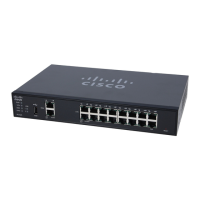• Port Start/ICMP Type/IP Protocol — Range of port numbers reserved for this service.
• Port End — Last number of the port, reserved for this service.
Step 8
Click Apply.
Network Address Translation
Network address translation (NAT) enables private IP networks with unregistered IP addresses to connect to
the network. NAT translates the private addresses of the internal network to public addresses before packets
are forwarded to the public network.
To configure NAT, follow these steps:
Step 1
Click Firewall > Network Address Translation.
Step 2
In the NAT Table, check Enable NAT for each interface on the Interface list to enable.
Step 3
Click Apply.
Static NAT
Static NAT is used to protect the LAN devices from discovery and attack. Static NAT creates a relationship
that maps a valid WAN IP address to LAN IP addresses that are hidden from the WAN (Internet) by NAT.
Step 1
Click Firewall > Static NAT.
Step 2
Click Add (or select the row and click Edit) and enter the information.
Enter the starting IP address of the internal IP address range to map to the public range.Private IP Range Begin
Enter the starting IP address of the public IP address range provided by ISP.
Do not include the router WAN IP address in this
range.
Note
Public IP Range Begin
Enter the number of IP addresses in the range.
The range length must not exceed the number of valid IP addresses. To map a
single address, enter 1.
Note
Range Length
Select the name of the service, from the drop-down list, to apply for the Static NAT.Services
Select the name of the interface from the drop-down list.Interfaces
Check Active to enable.Active
RV345/345P Administration Guide
70
Firewall
Network Address Translation

